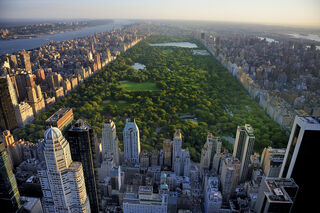Residential green spaces may boost cognitive function by lowering depression.
by Christopher Bergland
KEY POINTS
- Living near city parks or other green spaces is linked to lowered depression risk and better overall mental health.
- Residential green spaces are also linked to better cognitive function; this association appears to be mediated by lowered depression risk.
- Increasing greenery in urban areas may help offset cognitive decline in aging populations by lowering people’s risk of depression.

Source: Jirsak/Shutterstock
Accumulating evidence suggests that living near green spaces such as city parks, community gardens, and other greenery reduces stress and lowers depression.
A new data-driven paper (Jimenez et al., 2022) unearths fresh evidence that people who live near green spaces tend to be less depressed and, on average, have better cognitive functioning than those who don’t live near greenery. These findings were published on April 27 in the peer-reviewed journal JAMA Network Open.
Marcia Pescador Jimenez of Boston University’s School of Public Health (BUSPH) led this study. She conducted the data analysis with colleagues at Harvard Medical School’s Brigham and Women’s Hospital, the Harvard T.H. Chan School of Public Health, and Rush Medical College.
Their recently-published findings on the link between residential green spaces and cognitive function are based on analyzing data from the Nurses’ Health Study II, conducted from 2014 to 2017. The amount of greenery in residential green spaces was determined using a satellite image-based metric called the Normalized Difference Vegetation Index (NDVI).
“Some of the primary ways that nature may improve health is by helping people recover from psychological stress and encouraging people to be outside socializing with friends, both of which boost mental health,” Jimenez said in a news release.

Central Park is a massive 843-acre “green space.” It’s also the most visited urban park in America.
Source: T photography/Shutterstock
Before diving into this research, I’ll share some first-person lived experience of how having access to vibrant green spaces makes urban environments less depressing based on my observations of growing up in New York City during a period of urban decay and regeneration.
I was born on York Avenue in 1966 and grew up a few blocks from Central Park entrances on Manhattan’s Upper East Side. In the early ’70s, when I was growing up in NYC, “urban renewal” projects—that always seemed to involve bulldozing existing structures and building superhighways—were ubiquitous. One such project was the Cross Bronx Expressway, completed in 1972. This thoroughfare demolished homes, displaced communities, and obliterated the South Bronx’s green spaces in gut-wrenching ways.
The juxtaposition between where my family lived on 68th Street in Manhattan, surrounded by lots of birds and trees, and what I saw a few miles north in the South Bronx, where there seemed to be zero vegetation and lots of smog, was stark. Joni Mitchell summed up what urbanization and asphalt pavers were doing to nature in her environmental-conservancy anthem “Big Yellow Taxi.”
“They took all the trees and put ’em in a tree museum. And they charged the people a dollar and a half to see them. Don’t it always seem to go ya don’t know what you got ’til it’s gone? They paved paradise and put up a parking lot.” —”Big Yellow Taxi” by Joni Mitchell (1970)
The Lorax was published in 1971 and became an instant bestseller. Looking at New York through the lens of this eye-opening children’s book, I couldn’t help but view what was happening in the five boroughs as living proof of what environmental degradation feels like. Throughout the 1970s, even Central Park, which had been considered “The Lungs of the City” since 1858, suffered from neglect and degradation. By 1979, it wasn’t very grassy. With its greenery diminished, the park felt depressing.
When the Central Park Conservancy was created in 1980, it signified that New Yorkers on all sides of the park were rallying to preserve residential green spaces. As Central Park was revitalized and became a more vibrant green space, it also became a happier and more uplifting place—much like the illustrations of Thneedville bursting with color at the beginning of The Lorax, before all the Truffula trees are deforested.
Conversely, throughout the ’70s and well into the ’80s, many of New York City’s lower socioeconomic status (SES) neighborhoods didn’t have vibrant green spaces; they often seemed like bleak and depressing “gray spaces.” Much like Thneedville’s monotone wasteland after all the trees are gone in the final pages of The Lorax. (See, “How the Bronx Burned.”)
Research Shows That Living Near Green Spaces Lowers Depression and Boosts Cognition
Getting back to the recent (2022) JAMA Network Open paper: After adjusting for neighborhood socioeconomic status, age, and race, Jimenez et al. found that among a cohort of 13,594 study participants, green space exposure near someone’s home was associated with a lower incidence of depression.
These new findings support previous research (Gascon et al., 2018), which found that long-term exposure to green spaces has a protective effect on mental health and lowers depression risk.
As mentioned, Jimenez et al. also found that people who lived near green spaces tended to have better overall cognitive function scores, especially related to processing speed and attention. Yet, the million-dollar question remains: Why does living near green spaces improve cognitive functioning?
When formulating their research questions, the authors hypothesized that if residential green spaces are positively associated with better cognitive function in mid-life, this association would most likely be mediated by a triad of lower depression, higher physical activity, and less air pollution.
However, to their surprise, they found that lowered depression seemed to be the only mediating factor linked to better cognition among those residing near green spaces. That said, the researchers note that despite the findings of this particular study, their data analysis has limitations. There’s still a possibility that green spaces help decelerate cognitive decline by supporting physical activity, promoting psychological restoration, and/or reducing air pollution exposure.
“We theorize that depression might be an important mechanism through which green space may slow down cognitive decline, particularly among women, but our research is ongoing to better understand these mechanisms,” Jimenez said in a news release.
While this study shows evidence of the link between residential green spaces, better mental health, and improved cognitive function, it doesn’t specify what types of greenery are most beneficial. Future research by Jimenez and her team will apply deep learning algorithms to Google Street View images to try and pinpoint what specific types of greenery (e.g., trees, grass, shrubs) are the driving factors for better mental health and improved cognition.
“The distribution of green spaces in cities is not uniform,” Jimenez concludes. “Increasing everyday access to vegetation across vulnerable groups in urban cities is a crucial next step to achieve health equity.”

